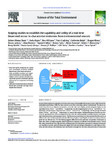Scoping studies to establish the capability and utility of a real-time bioaerosol sensor to characterise emissions from environmental sources
| dc.contributor.author | Nasir, ZA | |
| dc.contributor.author | Hayes, E | |
| dc.contributor.author | Williams, B | |
| dc.contributor.author | Gladding, T | |
| dc.contributor.author | Rolph, C | |
| dc.contributor.author | Khera, S | |
| dc.contributor.author | Jackson, S | |
| dc.contributor.author | Bennett, A | |
| dc.contributor.author | Collins, S | |
| dc.contributor.author | Parks, S | |
| dc.contributor.author | Attwood, A | |
| dc.contributor.author | Kinnersley, RP | |
| dc.contributor.author | Walsh, K | |
| dc.contributor.author | Alcega, SG | |
| dc.contributor.author | Pollard, SJT | |
| dc.contributor.author | Drew, G | |
| dc.contributor.author | Coulon, F | |
| dc.contributor.author | Tyrrel, S | |
| dc.date.accessioned | 2021-10-15T12:05:25Z | |
| dc.date.issued | 2019-01-15 | |
| dc.identifier.issn | 0048-9697 | |
| dc.identifier.issn | 1879-1026 | |
| dc.identifier.uri | http://hdl.handle.net/10026.1/18072 | |
| dc.description.abstract |
A novel dual excitation wavelength based bioaerosol sensor with multiple fluorescence bands called Spectral Intensity Bioaerosol Sensor (SIBS) has been assessed across five contrasting outdoor environments. The mean concentrations of total and fluorescent particles across the sites were highly variable being the highest at the agricultural farm (2.6 cm-3 and 0.48 cm-3, respectively) and the composting site (2.32 cm-3 and 0.46 cm-3, respectively) and the lowest at the dairy farm (1.03 cm-3 and 0.24 cm-3, respectively) and the sewage treatment works (1.03 cm-3 and 0.25 cm-3, respectively). In contrast, the number-weighted fluorescent fraction was lowest at the agricultural site (0.18) in comparison to the other sites indicating high variability in nature and magnitude of emissions from environmental sources. The fluorescence emissions data demonstrated that the spectra at different sites were multimodal with intensity differences largely at wavelengths located in secondary emission peaks for λex 280 and λex 370. This finding suggests differences in the molecular composition of emissions at these sites which can help to identify distinct fluorescence signature of different environmental sources. Overall this study demonstrated that SIBS provides additional spectral information compared to existing instruments and capability to resolve spectrally integrated signals from relevant biological fluorophores could improve selectivity and thus enhance discrimination and classification strategies for real-time characterisation of bioaerosols from environmental sources. However, detailed lab-based measurements in conjunction with real-world studies and improved numerical methods are required to optimise and validate these highly resolved spectral signatures with respect to the diverse atmospherically relevant biological fluorophores. | |
| dc.format.extent | 25-32 | |
| dc.format.medium | Print-Electronic | |
| dc.language | en | |
| dc.language.iso | en | |
| dc.publisher | Elsevier | |
| dc.subject | Real-time monitoring | |
| dc.subject | Bioaerosols | |
| dc.subject | Emissions characterisation | |
| dc.subject | Fluorescence spectra | |
| dc.title | Scoping studies to establish the capability and utility of a real-time bioaerosol sensor to characterise emissions from environmental sources | |
| dc.type | journal-article | |
| dc.type | Journal Article | |
| plymouth.author-url | https://www.webofscience.com/api/gateway?GWVersion=2&SrcApp=PARTNER_APP&SrcAuth=LinksAMR&KeyUT=WOS:000447805500003&DestLinkType=FullRecord&DestApp=ALL_WOS&UsrCustomerID=11bb513d99f797142bcfeffcc58ea008 | |
| plymouth.volume | 648 | |
| plymouth.publication-status | Published | |
| plymouth.journal | Science of the Total Environment | |
| dc.identifier.doi | 10.1016/j.scitotenv.2018.08.120 | |
| plymouth.organisational-group | /Plymouth | |
| plymouth.organisational-group | /Plymouth/Faculty of Health | |
| plymouth.organisational-group | /Plymouth/Faculty of Health/School of Biomedical Sciences | |
| plymouth.organisational-group | /Plymouth/Research Groups | |
| plymouth.organisational-group | /Plymouth/Research Groups/Institute of Translational and Stratified Medicine (ITSMED) | |
| plymouth.organisational-group | /Plymouth/Research Groups/Institute of Translational and Stratified Medicine (ITSMED)/CBR | |
| plymouth.organisational-group | /Plymouth/Users by role | |
| plymouth.organisational-group | /Plymouth/Users by role/Academics | |
| plymouth.organisational-group | /Plymouth/Users by role/Researchers in ResearchFish submission | |
| dc.publisher.place | Netherlands | |
| dcterms.dateAccepted | 2018-08-09 | |
| dc.rights.embargodate | 2021-10-16 | |
| dc.identifier.eissn | 1879-1026 | |
| dc.rights.embargoperiod | Not known | |
| rioxxterms.versionofrecord | 10.1016/j.scitotenv.2018.08.120 | |
| rioxxterms.licenseref.uri | http://www.rioxx.net/licenses/all-rights-reserved | |
| rioxxterms.licenseref.startdate | 2019-01-15 | |
| rioxxterms.type | Journal Article/Review |


